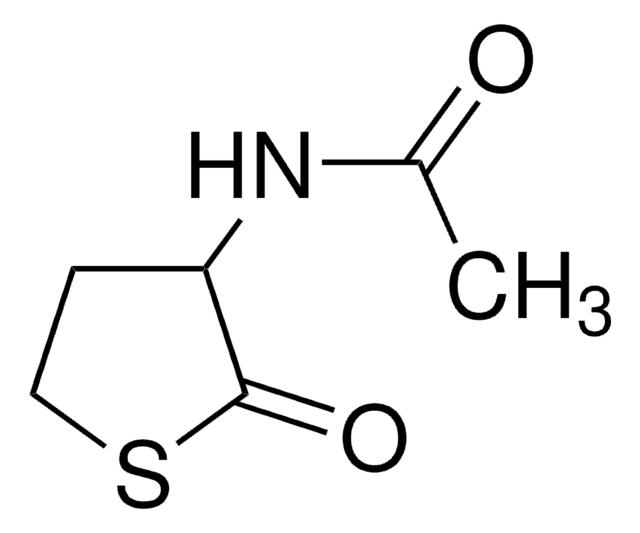H6503
L-Homocysteine thiolactone hydrochloride
≥98% (TLC)
Sinonimo/i:
L-2-Amino-4-mercaptobutyric acid 1,4-thiolactone hydrochloride
About This Item
Prodotti consigliati
product name
L-Homocysteine thiolactone hydrochloride, ≥98% (TLC)
Saggio
≥98% (TLC)
Forma fisica
powder
Colore
white
Punto di fusione
185 °C
applicazioni
detection
peptide synthesis
Stringa SMILE
Cl[H].N[C@H]1CCSC1=O
InChI
1S/C4H7NOS.ClH/c5-3-1-2-7-4(3)6;/h3H,1-2,5H2;1H/t3-;/m0./s1
ZSEGSUBKDDEALH-DFWYDOINSA-N
Cerchi prodotti simili? Visita Guida al confronto tra prodotti
Applicazioni
- Effects of DL-homocysteine thiolactone on cardiac contractility, coronary flow, and oxidative stress markers in the isolated rat heart: This investigation demonstrates the effects of DL-homocysteine thiolactone on heart function, offering insights into its use in cardiovascular research and potential therapeutic applications (Zivkovic et al., 2013).
- Homocysteine is a novel risk factor for suboptimal response of blood platelets to acetylsalicylic acid in coronary artery disease: The study explores how L-homocysteine thiolactone could affect platelet responses in therapy for coronary artery diseases, pointing to its importance in cardiovascular therapeutics (Karolczak et al., 2013).
Azioni biochim/fisiol
Codice della classe di stoccaggio
11 - Combustible Solids
Classe di pericolosità dell'acqua (WGK)
WGK 3
Punto d’infiammabilità (°F)
Not applicable
Punto d’infiammabilità (°C)
Not applicable
Dispositivi di protezione individuale
Eyeshields, Gloves, type N95 (US)
Certificati d'analisi (COA)
Cerca il Certificati d'analisi (COA) digitando il numero di lotto/batch corrispondente. I numeri di lotto o di batch sono stampati sull'etichetta dei prodotti dopo la parola ‘Lotto’ o ‘Batch’.
Possiedi già questo prodotto?
I documenti relativi ai prodotti acquistati recentemente sono disponibili nell’Archivio dei documenti.
I clienti hanno visto anche
Il team dei nostri ricercatori vanta grande esperienza in tutte le aree della ricerca quali Life Science, scienza dei materiali, sintesi chimica, cromatografia, discipline analitiche, ecc..
Contatta l'Assistenza Tecnica.











